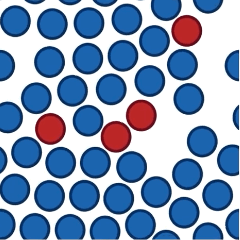Traffic of agents that can think
A group of agents can interact as they move to result in a traffic which is far more complex than the individual self. This complex traffic can be observed in a wide range of systems that range from droplets in a microchannel to human-vehicular traffic on roads (see figure below). Though the nature of interactions is very different in the two cases, like hydrodynamic interactions in the first case and psycho-teleological responses in the second, the underlying principles for traffic are very similar. For example, there is a fight for space as the agents move past each other (this is because two agents cannot occupy the same physical space), pursuit, and manoeuvre between groups of interacting traffic, fields (or purpose) driving average flow etc.

Image courtesy: Droplets in 2D microchannels- Beatus and co-workers, 2012; Caterpillar movement- https://www.youtube.com/watch?v=u_k8KTmxb8E; Traffic congestion- https://www.youtube.com/watch?v=iEIk3RpV6RA&t=35s
One can write mathematical models to study these systems from a more general setting. I find the model by Helbing, Farkas and Vicsek, particularly interesting and minimal. Their model consists of an interaction term which only takes into consideration a teleological driving force (sense of purpose, in this case, the desired direction), a repulsive term that keeps these agents from occupying the same space, walls that constrain movement and a random force term that modelled panic or indecision. They published this model in their paper in PRL in the year 2006, titled, "Freezing by heating in a driven mesoscopic system", where they showed that agents can exhibit a jammed state upon high levels of panic.
However, one of the most striking differences between inanimate and animate agents is the presence of memory. We learn from our mistakes; our memory of the past influences the decisions that we make in the present. Sometimes we try predicting the course of the future and tune our interactions appropriately. In this work, I introduce the concept of memory of an agent which alters the decision of an agent at any instant of time, based on its trajectory in the past. This leads to very interesting behaviour as shown in the video attached. [Note: The results below, do not have any random perturbation in the forces. Only the initial positions are perturbed slightly to break the symmetry]
We see that agents can exhibit a collective behaviour which is intelligent, irrespective of whether the agents are intelligent or not, to begin with. Ex: droplets that cannot think self-organize to reduce drag; ants, caterpillars, birds etc. with low cognitive capabilities show efficient collective locomotion, while intelligent humans exhibit traffic jams. That raises interesting questions: when will a group of intelligent agents exhibit un-intelligent behaviour and vice versa? To answer these questions, one has to derive simple mathematical models that include factors that account for the cognitive calibre of an agent. I believe that including memory into an agent-traffic model is a good start to a class of models that can explain living-agents with cognition.


